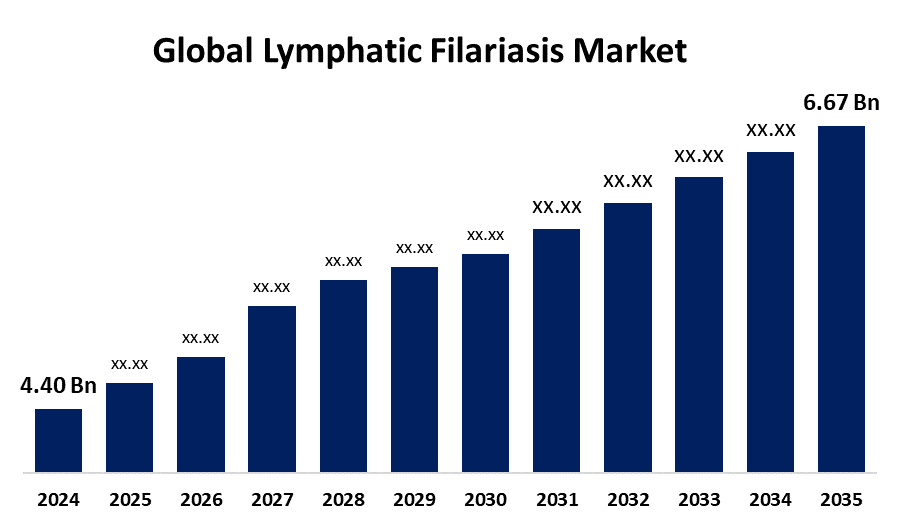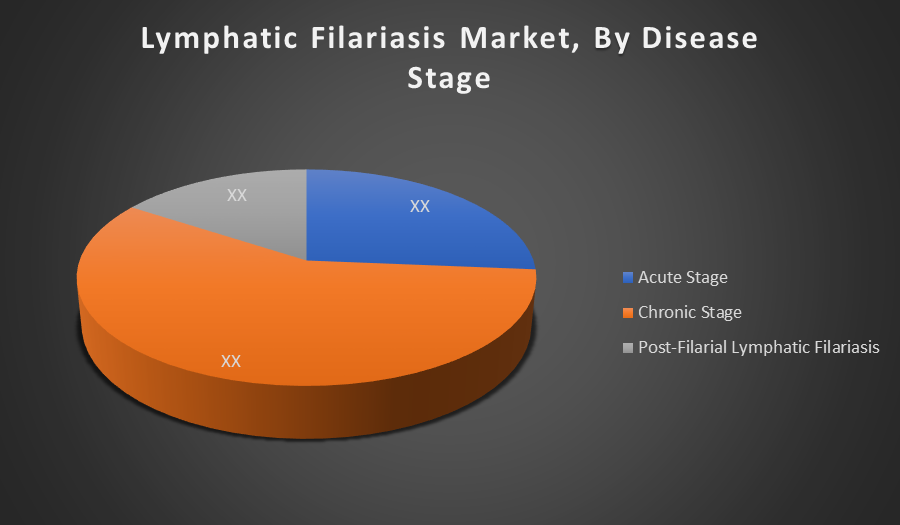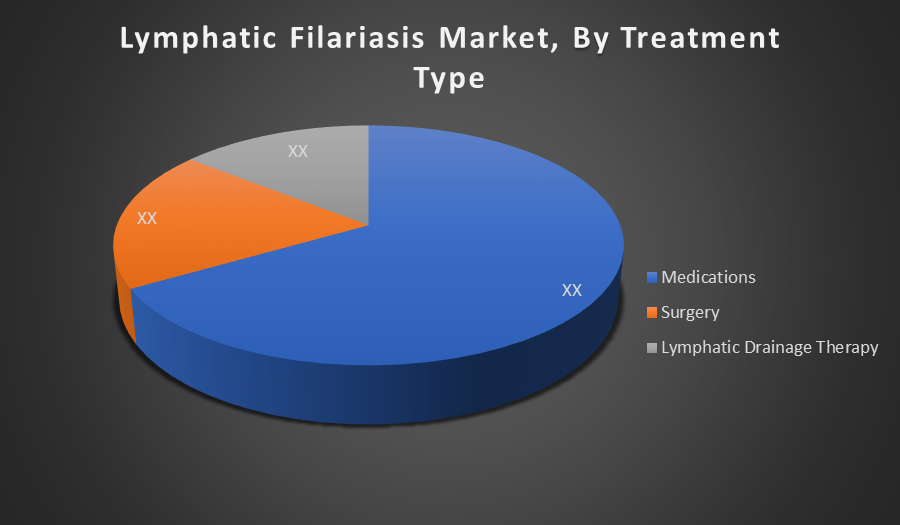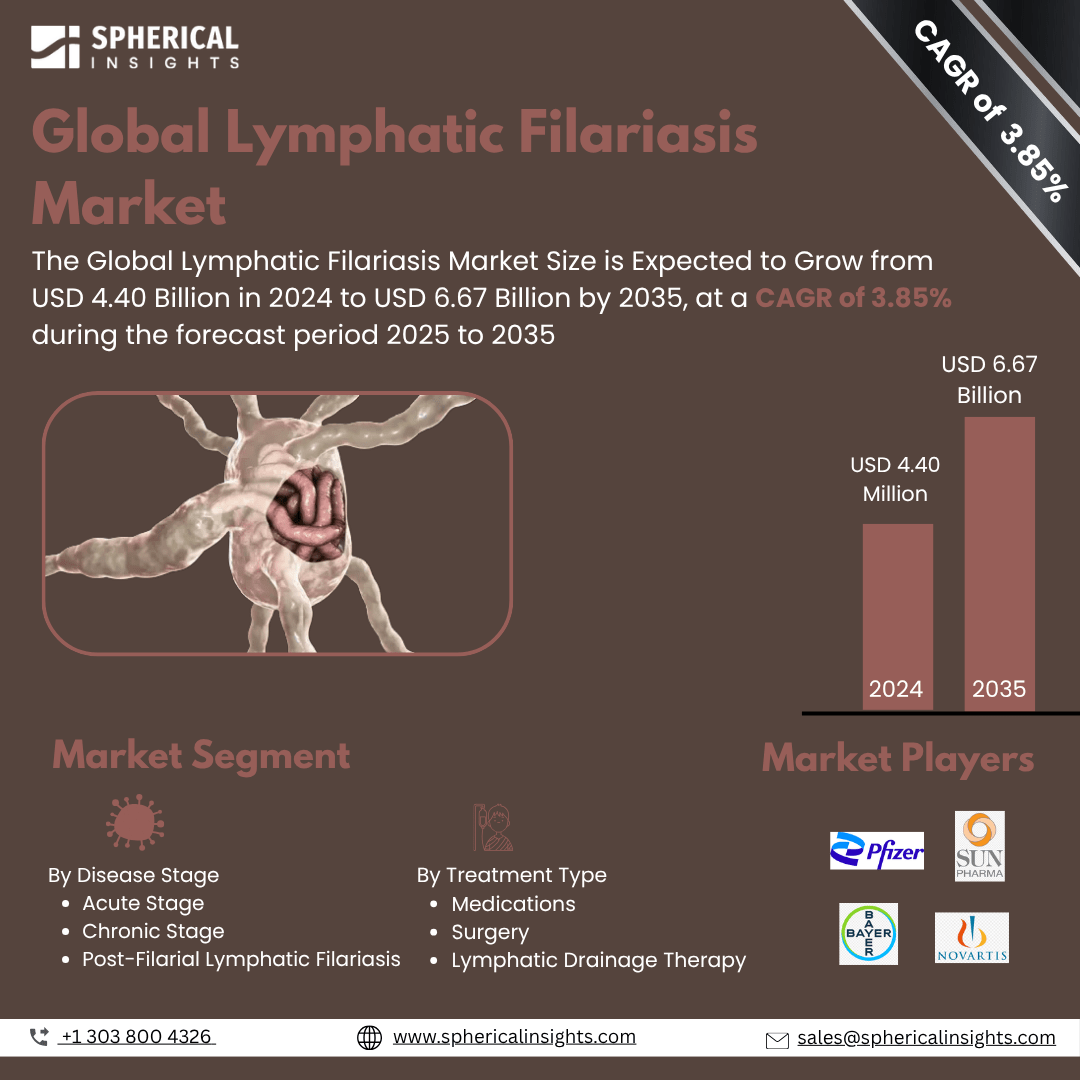- As per Spherical Insights & Consulting, The Global Lymphatic Filariasis Market Size is Expected to Grow from USD 4.40 Billion in 2024 to USD 6.67 Billion by 2035, at a CAGR of 3.85% during the forecast period 2025 to 2035, owing to the launch of new therapies in the market and the rise in the number of cases.
- The leading Lymphatic Filariasis Market Companies such as Pfizer Inc., Sun Pharmaceutical, Bayer AG, Dr. Reddy’s Laboratories, Novartis AG, Merck & Co., Cipla Ltd., Johnson & Johnson, GlaxoSmithKline, Lupin Limited, Teva Pharmaceutical Industries, Abbott Laboratories, Mylan N.V., Eisai Co., Ltd., and Others.
Lymphatic Filariasis Treatment Market: Understanding and Treatment Algorithm:
Lymphatic filariasis is a parasitic disease caused by filarial worms transmitted through mosquito bites. It leads to severe swelling, mainly in the legs and genital areas, due to lymphatic system damage. The disease is prevalent in tropical regions and causes chronic disability and social stigma for affected individuals.

Lymphatic Filariasis Diagnosis:
Diagnosis of lymphatic filariasis involves detecting microfilariae in blood samples, usually collected at night when parasites are most active. Serological tests like antigen detection and ultrasound imaging are also used to identify adult worms and lymphatic damage. Early diagnosis is crucial for effective treatment and disease management.
Lymphatic Filariasis Treatment:
Treatment includes antiparasitic medications such as diethylcarbamazine, ivermectin, and albendazole to kill microfilariae and adult worms. Supportive care like hygiene, wound management, and lymphatic drainage reduces symptoms. Mass drug administration campaigns aim to eliminate transmission in endemic areas by treating entire populations regularly.
Lymphatic Filariasis Epidemiology:
The disease epidemiology covered in the report provides historical as well as forecasted epidemiology segmented by Total Diagnosed Incident Population of Lymphatic Filariasis, Gender specific Diagnosed Incidence of Lymphatic Filariasis, Type specific Diagnosed Incidence of Lymphatic Filariasis, Age specific Diagnosed Incidence of Lymphatic Filariasis, Diagnosed Incident Population based on Primary Site of Lymphatic Filariasis, and Diagnosed Incident Population based on Histologic Classification of Lymphatic Filariasis Tumour in the global market covering North America, Europe, Asia-Pacific, Latin America, the Middle East, and Africa from 2024 to 2035.
Principal Insights:
This section offers a global overview of Lymphatic Filariasis epidemiology in major markets worldwide.
Country Wise Lymphatic Filariasis Multiforme Epidemiology:
- The epidemiology segment provides Lymphatic Filariasis prevalence data and findings across key regions worldwide, including North America, Europe (Germany, France, Italy, Spain, and the United Kingdom), Asia-Pacific (including Japan), Latin America, the Middle East, and Africa.
Lymphatic Filariasis: Recent Developments:
- In May 2024, Prof. Achim Hoerauf’s team, in collaboration with Eisai and research partners, secured 5.6 million from the Japanese GHIT Fund. This funding supported the preclinical development of corallopyronin A, an antibiotic targeting Wolbachia bacteria, aimed at treating river blindness and lymphatic filariasis.
Lymphatic Filariasis Marketed Drugs:
• Diethylcarbamazine (DEC): Eisai Co., Ltd.
Diethylcarbamazine is an anthelmintic drug widely used to treat lymphatic filariasis. It works by killing the microfilariae and some adult worms of Wuchereria bancrofti, Brugia malayi, and Brugia timori. DEC is often used in mass drug administration programs endorsed by the WHO to reduce disease transmission.
• Ivermectin: Merck & Co.
Ivermectin is an antiparasitic agent effective against microfilariae in lymphatic filariasis patients. It disrupts the nervous system of the parasites, causing paralysis and death. Ivermectin is a key component in combination therapies, such as with albendazole, and is widely used in mass treatment campaigns targeting endemic populations, especially in Africa and Asia.
Lymphatic Filariasis: Emerging Therapies:
- ABBV-4083: It is an investigational antibiotic targeting Wolbachia bacteria, an essential symbiont for filarial worms’ survival. By eliminating Wolbachia, this therapy disrupts the parasite’s life cycle, leading to sterilization and death of adult worms. ABBV-4083 is in late-stage clinical trials and shows promise as a safer, more effective alternative to traditional antifilarial drugs with shorter treatment durations.
- Emodepside: It is a novel antiparasitic drug originally developed for veterinary use but now being repurposed for lymphatic filariasis treatment. It targets the parasite’s neuromuscular system, causing paralysis and death. Emodepside is currently in early-phase clinical trials and may offer improved efficacy against adult worms, particularly in resistant cases.
Lymphatic Filariasis Market Outlook:
- The global lymphatic filariasis market includes diagnosis, treatment, and management of parasitic infections caused by filarial worms. It encompasses drugs, therapies, and healthcare services aimed at reducing disease burden, preventing transmission, and improving patient quality of life across endemic regions worldwide.
- Rising prevalence of lymphatic filariasis in tropical and subtropical regions, increased government mass drug administration programs, growing awareness about disease management, and advancements in diagnostic technologies collectively drive market growth. Expanding healthcare infrastructure in developing countries also supports increasing treatment accessibility.
- Emerging therapies targeting Wolbachia bacteria, improved drug delivery systems, and integration of digital health tools for early diagnosis present significant growth opportunities. Expanding public-private partnerships and rising investments in endemic regions enhance the potential for market expansion and disease elimination.
- Global and national governments, supported by WHO and NGOs, implement mass drug administration campaigns, awareness programs, and surveillance efforts to eliminate lymphatic filariasis. Funding for research and healthcare infrastructure development strengthens regional capacities to control and manage the disease effectively.
- Drug resistance and lack of healthcare access in remote endemic areas limit effective disease management.
- The market is projected to grow steadily due to intensified elimination efforts and innovative treatment development, enhancing disease control.
Lymphatic Filariasis Market Segmentation:
By Disease Stage:
- Acute Stage
- Chronic Stage
- Post-Filarial Lymphatic Filariasis

The Chronic Stage holds the largest market share because patients in this stage experience long-term complications such as elephantiasis, requiring ongoing medical intervention. Acute stages are often underdiagnosed, and post-filarial conditions are fewer, making chronic management the primary market driver due to sustained treatment needs.
By Treatment Type:
- Medications
- Surgery
- Lymphatic Drainage Therapy

Medications dominate the market share as they are the frontline treatment for both preventing and managing lymphatic filariasis infections. Surgery and lymphatic drainage therapy are less common, typically reserved for severe or chronic cases, limiting their market size compared to widely accessible and cost-effective drug therapies.
Regional Segment Analysis of the Lymphatic Filariasis Market:
The Asia-Pacific region holds the largest market share in the lymphatic filariasis market due to the high prevalence of the disease in countries such as India, Indonesia, Bangladesh, and the Philippines. Extensive government-led mass drug administration programs combined with growing healthcare infrastructure and increased public awareness fuel consistent demand for treatment. Support from international health organizations and improvements in diagnostics further strengthen the market position of this region.
Africa, particularly Sub-Saharan Africa, is the fastest-growing region in the lymphatic filariasis market. Countries such as Nigeria, Ghana, and the Democratic Republic of the Congo have significant disease burdens. Increasing funding from global health agencies, expanded access to healthcare, and intensified mass treatment campaigns are driving rapid market growth. Greater awareness programs and improved diagnostic capabilities also contribute to accelerating demand, making Africa a critical region for market expansion.
Lymphatic Filariasis Market Key Companies:
- Pfizer Inc.
- Sun Pharmaceutical
- Bayer AG
- Dr. Reddy’s Laboratories
- Novartis AG
- Merck & Co.
- Cipla Ltd.
- Johnson & Johnson
- GlaxoSmithKline
- Lupin Limited
- Teva Pharmaceutical Industries
- Abbott Laboratories
- Mylan N.V.
- Eisai Co., Ltd.
- Others
Lymphatic Filariasis Therapeutics Market Report Scope:
- The Lymphatic Filariasis therapeutics market report provides a detailed overview, covering its causes, symptoms, disease progression, and existing treatment options.
- Detailed insights into Lymphatic Filariasis’s epidemiology and therapeutic approaches are included.
- Additionally, a comprehensive review of existing and emerging Lymphatic Filariasis therapies is provided, including an evaluation of new treatments expected to influence the current Lymphatic Filariasis treatment market landscape.
- The report includes a detailed review of the Lymphatic Filariasis therapeutics market, both historical and forecasted, highlighting the global drug reach.
- The Patient-Based Lymphatic Filariasis Market Forecasting report offers valuable insights into trends shaping the global Lymphatic Filariasis market, helping to develop effective business strategies.
Lymphatic Filariasis Treatment Market Report Insights:
- Forecasting Market Trends Based on Patient Data and Disease Rates
- Lymphatic Filariasis Therapeutic Approaches in Lymphatic Filariasis
- Review Of Drugs in Development for Lymphatic Filariasis
- Market, Growth, and Trends in Lymphatic Filariasis
- Market Opportunities in Lymphatic Filariasis Treatment
- Effects Of Future Therapies on Lymphatic Filariasis Treatment.
Lymphatic Filariasis Treatment Market Report Key Strengths
- 15 Years Lymphatic Filariasis Market Forecast
- Global Coverage
- Lymphatic Filariasis Epidemiology Segmentation
- Key Cross Competition
Lymphatic Filariasis Treatment Market Report Assessment
- Present Practices in the Lymphatic Filariasis Treatment Market
- Review of Investigational Lymphatic Filariasis Drugs
- Attractiveness of the Lymphatic Filariasis Drug Market
- Lymphatic Filariasis Market Drivers
- Lymphatic Filariasis Market Barriers
- SWOT
- Attribute Analysis
Market Segment:
This study forecasts revenue at the global, regional, and country levels from 2020 to 2035. Spherical Insights has segmented the Lymphatic Filariasis market based on the following segments:
Global Lymphatic Filariasis Market, By Disease Stage
- Acute Stage
- Chronic Stage
- Post-Filarial Lymphatic Filariasis
Global Lymphatic Filariasis Market, By Treatment Type
- Medications
- Surgery
- Lymphatic Drainage Therapy
Global Lymphatic Filariasis Market, By Regional Analysis
- North America
- Europe
- Germany
- UK
- France
- Italy
- Spain
- Russia
- Rest of Europe
- Asia Pacific
- China
- Japan
- India
- South Korea
- Australia
- Rest of Asia Pacific
- South America
- Brazil
- Argentina
- Rest of South America
- Middle East & Africa
- UAE
- Saudi Arabia
- Qatar
- South Africa
- Rest of the Middle East & Africa






